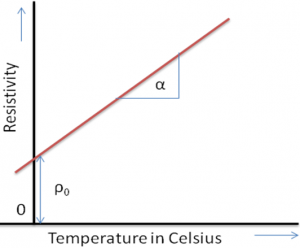Temperature dependence of Resistance
Resistance is fundamentally the ability of the material to restrict the passage of electric current. Thus, just as material properties such as density, size, magnetization etc. change with temperature, so doe’s resistance. Resistance is really a bulk property; the resistivity on the other hand is a material property.
Resistivity of Metals: The resistivity (ρ) of metals is dependent on the relaxation time (τ) of the free electrons in the metal as,
\(\rho \,\,\propto \,\frac{1}{\tau }\)
The relaxation time is dependent on the mean free path (λ) and the root mean square speed (vrms) of the electron as:
\(\tau \,=\,\frac{{{v}_{rms}}}{\lambda }\)
\(\rho \,\,\propto \,\,\frac{1}{\tau }\,\,\propto \,\,\frac{\lambda }{{{v}_{rms}}}\)
Since the root mean square speed increases with temperature and mean free path, the resistivity and hence the resistance of the metal also rises.
This is mostly linear and is given as:
ρ₁ = ρ₀ (1 + αt)
Where ρt is the resistivity at t degrees centigrade and ρ₀ is the resistivity at 0 degrees Celsius.

Resistivity of Semiconductors: The number of charge carriers of semiconductors like Germanium and Silicon is lesser than those of metals but more than in insulators. These carriers are generated by thermal breaking of bonds. Thus as the temperature rises, more number of covalent bonds break, releasing more electrons which lowers the resistivity rapidly. This Temperature dependence is usually exponential which makes semiconductors very useful in electronic circuits detecting small changes in temperature.
![]()
